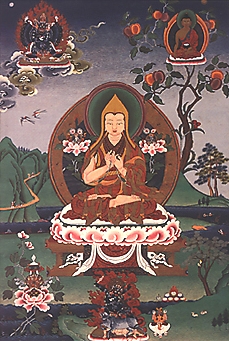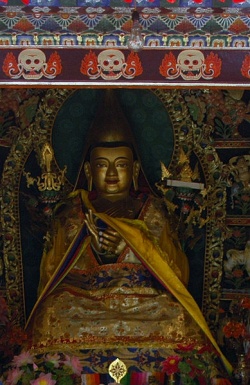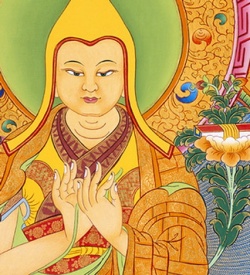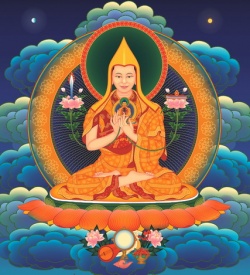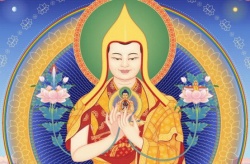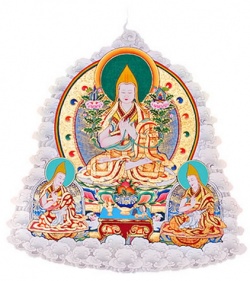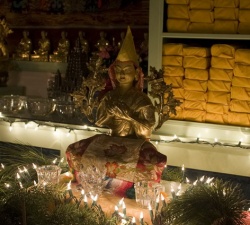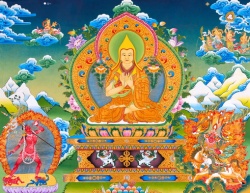Je Tsong Khapa by Peter Morrell
Je Tsong Khapa
Tibetan Thinker, Tibetan Buddhist
1357-1419
Information compiled by Peter Morrell
Born in Amdo eastern Tibet, Je Tsong Khapa (1357-1419) (the name means 'he born in the onion (Tsong) place') is widely regarded in Tibet as a second Buddha and the main teacher of the first Dalai Lama, Gendun Drub (1391-1474).
He was an eminent scholar who reformed the old Kadampa sect, creating the new Gelugpa sect ('System of Virtue,' popularly known as the Yellow Hats), which was to become the most powerful in the entire region, eventually converting Mongolia and all other Himalayan kingdoms to Tibetan Buddhism. After his passing, the sect Tsongkhapa founded was to become the most powerful in the entire region, eventually converting Mongolia and all other Himalayan kingdoms to Tibetan Buddhism. He established in 1409 the massive Ganden Monastic University, east of Lhasa, and one of the largest monasteries in the entire Himalayan region with, at its height, many thousands of monks. It has been in ruins since the excesses of the Cultural Revolution of the 1960's. Since 1986 a small part of it has been restored for a few hundred monks and laypersons. He also founded the two other big Yellow Hat monasteries of central Tibet, Dre-pung in 1416, to the west of Lhasa and Sera Je in 1419 to the north of the capital. No monastic university in Tibet has survived Chinese rule intact.
Taught from early childhood by numerous lamas of different traditions, Tsong Khapa traveled widely in Tibet collecting teachings, lineages and empowerments until he had thoroughly mastered all aspects of Buddhist logic and practice. His two key innovations were his emphasis on strict monasticism, and his presentation of an interpretation of all four of the major schools of Buddhist dogma as fundamentally consistent.
He is revered by Tibetans as an emanation of the Buddha of wisdom, Manjushri. Just as the artist and poet, William Blake, had persistent visions of angels, so Tsong Khapa is reported to have regularly seen and conversed with Manjushri from an early age.
He wrote extensively on every aspect of Buddhism, his main work being 'The Great Exposition of the Path' (Tib: Lam rim chen mo) which:
- '(It)...provided perhaps the clearest and most inclusive analysis of the Buddhist path that had yet been written. His voluminous commentaries on every imaginable topic...provided the largest and most integrated corpus of scripture written by a Tibetan mind.' (Dowman, 1988, p.31).
His second major work is the 'Great Exposition of the Path of Secret Mantra' (Tib: ngak rim chen mo), which is an exhaustive compendium on all the Tibetan tantra systems, and:
- '...presents the main features of all the Buddhist tantra systems as well as the difference between sutra and tantra, the two divisions of Buddha's word.' (Tantra In Tibet, 1977, p.8).
His 'Three Principal Aspects of the Path', presented here, is a highly compressed piece of writing which has attracted numerous commentaries since it first appeared.
Acknowledgement I am gratefully indebted to Lhundup Damcho for helpful advice in the compilation of this revised version of this profile.
The Three Principal Aspects of the Path by Je Tsong Kha pa
I will explain as well as I can
The essential meaning of all the Conqueror's scriptures,
The path praised by the excellent Conqueror children,
The port for the fortunate wishing liberation.
Whoever are not attached to the pleasures of mundane existence,
Whoever strive in order to make leisure and fortune worthwhile,
Whoever are inclined to the path pleasing the Conqueror Buddha,
Those fortunate ones should listen with a clear mind.
Without a complete thought definitely to leave cyclic existence
There is no way to stop seeking pleasurable effects in the ocean of existence.
Also, craving cyclic existence thoroughly binds the embodied.
Therefore, in the beginning determination to leave cyclic existence should be sought.
Leisure and fortune are difficult to find
And life has no duration.
Through familiarity with this,
Emphasis on the appearances of this life is reversed.
If you think again and again
About deeds and their inevitable effects
And the sufferings of cyclic existence,
The emphasis on the appearances
Of future lives will be reversed.
If, having meditated thus, you do not generate admiration
Even for an instant for the prosperity of cyclic existence,
And if an attitude seeking liberation arises day and night,
Then the thought definitely to leave cyclic existence has been generated.
Also, if this thought definitely to leave cyclic existence
Is not conjoined with generation of a complete aspiration to highest enlightenment,
It does not become a cause of the marvellous bliss of unsurpassed enlightenment.
Thus, the intelligent should generate the supreme altruistic intention to become enlightened.
All ordinary beings are carried by the continuum of the four powerful currents,
Are tied with the tight bonds of actions difficult to oppose,
Have entered into the iron cage of apprehending self (inherent existence),
Are completely beclouded with the thick darkness of ignorance,
Are born into cyclic existence limitlessly, and in their births
Are tortured ceaselessly by the three sufferings.
Thinking thus of the condition of mothers who have come to such a state,
Generate the supreme altruistic intention to become enlightened.
If you do not have the wisdom realising the way things are,
Even though you have developed the thought definitely to leave cyclic existence
And the altruistic intention, the root of cyclic existence cannot be cut.
Therefore work at the means of realising dependent-arising.
Whoever, seeing the cause and effect of all phenomena
Of cyclic existence and nirvana infallible,
Thoroughly destroys the mode of misapprehension of those objects (as inherently existent)
Has entered on a path that is pleasing to Buddha.
As long as the two, realisation of appearances -
the infallibility of dependent-arising - and the realisation of emptiness -
The non-assertion (of inherent existence) -
Seem to be separate, there is still no realisation
Of the thought of Shakyamuni Buddha.
When (the two realisations exist) simultaneously without alternation
And when from only seeing dependent-arising as infallible,
Definite knowledge entirely destroys the mode of apprehension
(of the conception of inherent existence),
then the analysis of the view (of reality) is complete.
Further, the extreme of (inherent) existence is excluded
(by knowledge of the nature) of appearances
(existing only as nominal designations),
And the extreme of (total) non-existence is excluded
(by knowledge of the nature) of emptiness
(as the complete absence of inherent existence and not the absence of nominal existence).
If within emptiness the appearance of cause and effect is known
You will not be captivated by extreme views.
When you have realised thus just as they are
The essentials of the three principal aspects of the path,
Resort to solitude and generate the power of effort.
Accomplish quickly your final aim, my child.
(extracted from Kindness Clarity and Insight, Dalai Lama XIV, 1981, Snow Lion, USA; translated by Jeffrey Hopkins, University of Virginia.)
Summary
The 3 principal aspects of the path are:
- the definite thought to leave cyclic existence and the abandonment of pleasure;
- the cultivation of an altruistic intention (strong compassion) by viewing all beings as precious as our own mother;
- the correct view of emptiness.
Tsong Khapa suggests that possessing one or two of these alone is not enough - all three must be thoroughly and completely developed to create a true Buddhist path. KEY TERMS:
ALTRUISTIC INTENTION - desire to attain enlightenment in order solely to be of help to others; the Bodhisattva ideal of the Mahayana school of Buddhism.
DEEDS AND THEIR EFFECTS - karma, the view that all our actions, thoughts and words attract negative or positive seeds which remain with us, acting as causes of future happiness or misery.
DEFINITE KNOWLEDGE - knowledge about how things are; realisations, correct views; Buddhist wisdom, especially about the empty nature of all phenomena.
DEPENDENT ARISING - objects which arise dependent upon component parts or upon other objects; ie. most things.
EMPTINESS - the quality which all things possess; they are empty of inherent existence; their emptiness is the real solid and lasting nature we cannot find in anything through sustained conceptual analysis; thus things are viewed as being fundamentally empty of true existence; a view begun by Buddha, but later elucidated in detail by the Indian sage Nagarjuna (c100-c200 AD).
ENLIGHTENMENT - release from samsara and wrong views; attainment of realisation, wisdom, etc.
EXTREME VIEWS - the extreme philosophical positions of eternalism or nihilism regarding the nature of mind.
FOUR POWERFUL CURRENTS - birth, aging, sickness and death.
INHERENT EXISTENCE - something which has inherent existence from its own side and is not a dependent arising.
SAMSARA - cyclic existence - the physical world, the world we are repeatedly born and reborn into.v
SHAKYAMUNI BUDDHA, CONQUEROR - the historical Buddha, king of the Shakya tribe, (c563-483BC).
SUTRA - a general term for all Buddhist texts, especially those which claim to be the actual word of Buddha; as opposed to 'shastras' or Buddhist commentaries.
TANTRA - a specific form of meditation manual for use in the tantric system of Buddhism, almost exclusive to the Tibetan region; also called Secret Mantra or Vajrayana - the 'diamond vehicle'; any one of a number of secret Buddhist texts.
THREE SUFFERINGS - desire, hatred and delusion.
Sources
- Dowman, Keith, 1988, The Power-Places of Central Tibet, RKP, London & New York
- Gyatso, Tenzin, 1981, Kindness Clarity & Insight, Snow Lion, USA
- Hopkins, Jeffrey, 1999, Emptiness in the Mind-Only School of Buddhism, University of California Press, USA (This is a translation and commentary on Tsongkhapa's Essence of Eloquence, includes a concise biography, pages 6-12)
- Mullin, Glenn H, 1981, Selected Works of the Dalai Lama I, Snow Lion, USA
- Mullin, Glenn H, 1982, Selected Works of the Dalai Lama VII, Snow Lion, USA
- Thurman, Robert (ed.), 1993, Life and Teachings of Tsong Khapa, Library of Tibetan Works & Archives, India
- Tsong Khapa, 1977, Tantra In Tibet, Allen & Unwin, London
- Tsong Khapa, 1980, Yoga Of Tibet, Allen & Unwin, London
- Vessantara, 1993, Meeting the Buddhas, Windhorse, Glasgow
